Related Research Articles

The Atari 5200 SuperSystem or simply Atari 5200 is a home video game console introduced in 1982 by Atari, Inc. as a higher-end complement for the popular Atari Video Computer System. The VCS was renamed to Atari 2600 at the time of the 5200's launch. Created to compete with Mattel's Intellivision, the 5200 wound up a direct competitor of ColecoVision shortly after its release. While the Coleco system shipped with the first home version of Nintendo's Donkey Kong, the 5200 included the 1978 arcade game Super Breakout, which had already appeared on previous Atari home platforms.

The Atari 8-bit computers, formally launched as the Atari Home Computer System, are a series of home computers introduced by Atari, Inc., in 1979 with the Atari 400 and Atari 800. The architecture is designed around the 8-bit MOS Technology 6502 CPU and three custom coprocessors which provide support for sprites, smooth multidirectional scrolling, four channels of audio, and other features. The graphics and sound are more advanced than most of its contemporaries, and video games are a key part of the software library. The 1980 first-person space combat simulator Star Raiders is considered the platform's killer app.

Kaboom! is an action video game published in 1981 by Activision for the Atari 2600. The game involves a Mad Bomber dropping bombs at increasing speeds as the player controls a set of water buckets to catch them. The gameplay was based on the Atari arcade video game Avalanche (1978). Kaboom! was programmed by Larry Kaplan with David Crane coding the graphics for the buckets and Mad Bomber. It was the last game designed by Kaplan for Activision, who left the company shortly after it was released. The game was later ported by Paul Wilson for the Atari 5200 system.

Pitfall! is a video game developed by David Crane for the Atari 2600 and released in 1982 by Activision. The player controls Pitfall Harry, who has a time limit of 20 minutes to seek treasure in a jungle. The game world is populated by enemies and hazards that variously cause the player to lose lives or points.

Miner 2049er is a 1982 platformer game developed and published by Big Five Software in December 1982. It is set in a mine, where the player controls the Mountie Bounty Bob. The player controls Bounty Bob through multiple levels of a mine, with the goal of traversing all of the platforms in each level all while avoiding enemies and within a set amount of time.

Silent Service is a submarine simulator video game designed by Sid Meier and published in 1985 by MicroProse for the Apple II, Atari 8-bit computers, Commodore 64, and IBM PC compatibles, then ported to other home computers. A Nintendo Entertainment System version developed by Rare was published in 1989 by Konami in Europe and by Konami's Ultra Games subsidiary in North America. Silent Service II was released in 1990. Tommo purchased the rights to this game and published it online through its Retroism brand in 2015.
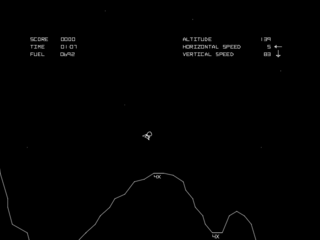
Lunar Lander is a genre of video games loosely based on the 1969 landing of the Apollo Lunar Module on the Moon. In Lunar Lander games, players control a spacecraft as it falls toward the surface of the Moon or other astronomical body, using thrusters to slow the ship's descent and control its horizontal motion to reach a safe landing area. Crashing into obstacles, hitting the surface at too high a velocity, or running out of fuel all result in failure. In some games in the genre, the ship's orientation must be adjusted as well as its horizontal and vertical velocities.
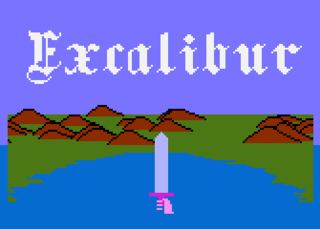
Excalibur is a resource management strategy video game for Atari 8-bit computers published in 1983. It was designed by Chris Crawford and developed with the help of Larry Summers and Valerie Atkinson. Like Crawford's earlier Eastern Front (1941), Excalibur was released through the Atari Program Exchange.

Tempest is a 1981 arcade video game by Atari, Inc., designed and programmed by Dave Theurer. It takes place on a three-dimensional surface divided into lanes, sometimes as a closed tube, and viewed from one end. The player controls a claw-shaped "blaster" that sits on the edge of the surface, snapping from segment to segment as a rotary knob is turned, and can fire blaster shots to destroy enemies and obstacles by pressing a button.

Spelunker is a 1983 platform video game developed by Timothy G. Martin of MicroGraphic Image. It is set in a cave, with the player starting at the cave's entrance at the top, and the objective is to get to the treasure at the bottom.

Keystone Kapers is a platform game developed by Garry Kitchen for the Atari 2600 and published by Activision in 1983. The game involves a Keystone Cops theme, with the player controlling police officer Kelly, who traverses the many levels of a department store, dodging objects to catch the escaped thief Harry Hooligan.
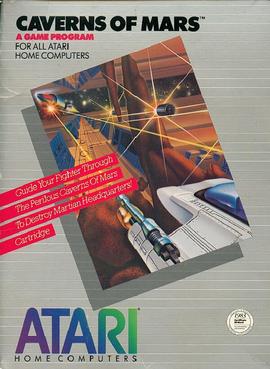
Caverns of Mars is a vertically scrolling shooter for Atari 8-bit computers. It was written by Greg Christensen, with some features later added by Richard Watts, and published by the Atari Program Exchange (APX) in 1981. Caverns of Mars became the best selling APX software of all-time and was moved into Atari, Inc.'s official product line, first on diskette, then on cartridge.
Robert A. Whitehead is an American video game designer and programmer. While working for Atari, Inc. he wrote two of the nine Atari Video Computer System launch titles: Blackjack and Star Ship. After leaving Atari, he cofounded third party video game developer Activision, then Accolade. He left the video game industry in the mid-1980s.

Several video games and genres have been created as a result of the release of the film E.T. the Extra-Terrestrial based on the story and themes of the original game.
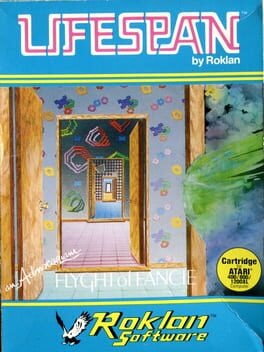
Lifespan is a video game written by John O'Neill for Atari 8-bit computers. It was published on cartridge by Roklan in 1983, then released on disk in 1985 by Antic Software.
Russ Wetmore is an American programmer and video game designer best known for writing commercial games and applications for Atari 8-bit computers in the early to mid 1980s. His Frogger-inspired Preppie! was published by Adventure International and praised by reviewers for the music and visuals. He also wrote the maze-game sequel, Preppie! II. Wetmore stopped writing games after the video game crash of 1983 and developed the integrated HomePak productivity suite for Batteries Included. He has remained in software development in director and architecture roles.
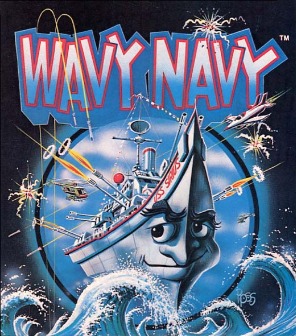
Wavy Navy is a video game designed by Rodney McAuley for the Apple II and published by Sirius Software in 1983. Versions for the Atari 8-bit computers and Commodore 64 were released the same year. Wavy Navy is a nautically themed fixed shooter with left and right controls to move the player's PT boat, but there is an additional vertical element as the boat moves up and down with the large ocean waves that scroll beneath it. The direction and speed of the waves vary per level. Some reviewers found that the movement of the waves added an interesting twist, while others called it too similar to other fixed shooters like Galaxian.

Chopper Hunt is a side-view shoot 'em up written by Tom Hudson and published by Imagic in 1984 for Atari 8-bit computers and Commodore 64. It was one of the last games from Imagic before the company went out of business. Chopper Hunt is an enhanced version of the Atari 8-bit game Buried Bucks released by ANALOG Software in 1982. In both games, the player files a helicopter that uses bombs to unearth buried items. Contemporaneous reviews were mixed.
Movie Maker is a computer program published by Reston Publishing Company in 1984 which allows users to author animated visual sequences with audio. Self-playing movies can be viewed without the Movie Maker software. It was developed by Interactive Picture Systems for Atari 8-bit computers. In 1985 it was re-published by Electronic Arts, including a port to the Commodore 64.

RealSports Baseball is a 1982 sports video game developed and published by Atari, Inc. originally for the Atari 2600. It was also launched on the Atari 5200 and 7800 machines. A version for the Atari 8-bit computers was in development, but cancelled.
References
- 1 2 3 4 5 6 7 8 9 10 11 12 Blakeman, Mary Claire (January 1984). "The Art Side of Video Games". Video Games. 2 (4). Pumpkin Press: 27–30. ISSN 0733-6780.
- 1 2 3 4 5 6 7 8 9 10 11 Forman, Tracie (July 1984). "Inside Gaming – John O'Neill: The Dali of Computer Gaming". Electronic Games . 2 (13). Reese Publishing Company, Inc.: 64–65. ISSN 0730-6687.
- 1 2 3 4 5 6 7 8 9 Yaktal, Kathy (December 1985). "Designers with a Difference: New Approaches to Computer Games". COMPUTE!'s Gazette . 3 (12, Iss. 30). ABC Publishing: 24–32. ISSN 0737-3716.
- 1 2 3 4 Kunkel, Bill (March 1986). "Entertainment: Software Section – The Dolphin's Rune". Ahoy! (27). Ion International: 44–46. ISSN 8750-4383.
- ↑ "About the Artist". Archived from the original on 12 December 2008. Retrieved 25 September 2013.
{{cite web}}: CS1 maint: bot: original URL status unknown (link). See Through Games. 2006. - ↑ O'Neill, John. Box 1. ATCA Artists' Works and Correspondence Files Collection, The University of Iowa Libraries, Iowa City, Iowa.
- ↑ Peterson, Dale (1983). Genesis II: Creation and Recreation with Computers . Reston Publishing. pp. 89–91. ISBN 9780835924344.
- 1 2 Jones, Beverly J. (1990). "Computer Graphics: Effects of Origins – Recent and Contemporary Computer Graphics". Leonardo (Digital Image-Digital Cinema Supplemental Issue). Pergamon Press: 21–30. ISSN 0024-094X.
- 1 2 O'Neill, John (December 2007). "Green Holiday Gift Guide: Paradice – A Fusion of Art & Game: A Green Game for Today's Consciousness". Connection: 21.
- 1 2 Uston, Ken; Leyenberger, Arthur (May 1984). "Computer Games Flourish at CES – Prentice Hall". Creative Computing . 10 (5). Ideametrics: 145. ISSN 0097-8140.
- ↑ Forman, Tracy (March 1984). "Computer Gaming: Software – Lifespan". Electronic Games . 2 (12). Reese Publishing Company, Inc.: 38–40. ISSN 0730-6687.
- ↑ Friedland, Nat, ed. (November 1984). "New Products – The Dolphin's Pearl / Middle of the Road Lizard / Day". Antic . 3 (7). ANTIC Pub.: 85. ISSN 0745-2527.
- ↑ Bisson, Gigi; Friedland, Nat; Powell, Jack (December 1985). "Fourth Annual Antic Shoppers Guide: Software – Lifespan". Antic . 4 (8). ANTIC Pub.: 38. ISSN 0745-2527.
- 1 2 Kunkel, Bill (September 1986). "The Sound of Entertainment: How Audio Enhances Commodore Entertainment Programs – The Best Sounds In Entertainment". Ahoy! (33). Ion International: 50. ISSN 8750-4383.
- ↑ Moyer, Robert (3 October 2009). "Game profile: Paradice". Pittsburgh Board Game Examiner.
- ↑ "Freshman Class–Toy Fair newcomers: a healthy mix of first-timers invigorate the exhibitor mix". Playthings . Geyer-McAllister Publications. 1 January 2005. ISSN 0032-1567.
- ↑ Terman, Jennifer (16 May 2013). "Renowned artist, game designer to host game nights in Nevada City". The Union . Archived from the original on 27 September 2013. Retrieved 25 September 2013.
- ↑ "Day (TM)." WorldCat. 2013.
- ↑ Mansfield, Richard, ed. (February 1986). "Also Worth Noting – The Dolphin's Rune: A Poetic Odyssey". COMPUTE!'s Gazette . 4 (2, Iss. 32). ABC Publishing: 75. ISSN 0737-3716.
- ↑ "Paradice (2001)." BoardGameGeek. Retrieved 22 September 2013.
- ↑ Berlinger, Yehuda. Purple Pawn . Newstex. 18 September 2010.
- ↑ "Ice Cap (2009)." BoardGameGeek. Retrieved 22 September 2013.